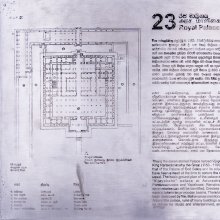Ciriya, Cīriya, Siriyā: 4 definitions
Introduction:
Ciriya means something in Buddhism, Pali, Jainism, Prakrit, Tamil. If you want to know the exact meaning, history, etymology or English translation of this term then check out the descriptions on this page. Add your comment or reference to a book if you want to contribute to this summary article.
Images (photo gallery)
Languages of India and abroad
Pali-English dictionary
Source: Sutta: The Pali Text Society's Pali-English DictionaryCīriya, (adj.) (fr. cīra) like or of bark, in cpd. dāru° (as Np.) “wood-barker” DhA.II, 35. (Page 269)

Pali is the language of the Tipiṭaka, which is the sacred canon of Theravāda Buddhism and contains much of the Buddha’s speech. Closeley related to Sanskrit, both languages are used interchangeably between religions.
Prakrit-English dictionary
Source: DDSA: Paia-sadda-mahannavo; a comprehensive Prakrit Hindi dictionary1) Cīriya (चीरिय) in the Prakrit language is related to the Sanskrit word: Cīrika.
2) Cīriyā (चीरिया) also relates to the Sanskrit word: Cīrikā.
Prakrit is an ancient language closely associated with both Pali and Sanskrit. Jain literature is often composed in this language or sub-dialects, such as the Agamas and their commentaries which are written in Ardhamagadhi and Maharashtri Prakrit. The earliest extant texts can be dated to as early as the 4th century BCE although core portions might be older.
Tamil dictionary
Source: DDSA: University of Madras: Tamil LexiconCīriya (சீரிய) adjectival perhaps from idem. Of surpassing excellence; சிறப்பான. சீரிய சிங்காதனத் திருந்து [sirappana. siriya thirumadal singathanath thirunthu] (நாலாயிர திவ்யப்பிரபந்தம் திருப்பாவை [nalayira thivyappirapandam thiruppavai] 23).
Tamil is an ancient language of India from the Dravidian family spoken by roughly 250 million people mainly in southern India and Sri Lanka.
Nepali dictionary
Source: unoes: Nepali-English DictionarySiriyā (सिरिया):—n. Syria;
Nepali is the primary language of the Nepalese people counting almost 20 million native speakers. The country of Nepal is situated in the Himalaya mountain range to the north of India.
See also (Relevant definitions)
Starts with (+8): Ciriya mukkurattai, Ciriya nankai, Ciriya nantai, Ciriya-katukkoti, Ciriya-tirumatal, Ciriyakarpu, Ciriyakki-palan-calakaiaccu, Ciriyakkiyaccu, Ciriyal, Ciriyalu, Ciriyamaratti, Ciriyamatti, Ciriyanankai, Ciriyanca Paya, Ciriyanca-paya, Ciriyaputpam, Ciriyar, Ciriyatailam, Ciriyatakappan, Ciriyatay.
Ends with: Cinnanciriya, Daruciriya.
Full-text (+106): Cirika, Chiriya-kanda, Ciriya mukkurattai, Ciriya nantai, Ciriya nankai, Ciriya-katukkoti, Chiriya bajra, Chiriya ro khet, Chiriya ke chaolai, Siriya nangai, Chiriya-nantai, Chiriya-nankai, Daruciriya, Cirutayar, Ittiya, Kaivatti, Totaivillai, Nakaiccellam, Kuttiyappan, Citteri.
Relevant text
Search found 10 books and stories containing Ciriya, Cīriya, Cīriyā, Siriya, Seeriya, Chiriya, Siriyā; (plurals include: Ciriyas, Cīriyas, Cīriyās, Siriyas, Seeriyas, Chiriyas, Siriyās). You can also click to the full overview containing English textual excerpts. Below are direct links for the most relevant articles:
Temples of Munnur (Historical Study) (by R. Muthuraman)
Images of Anjaneya < [Chapter 5]
Later Chola Temples (by S. R. Balasubrahmanyam)
Temples in Chilakalanerpu < [Chapter II - Temples of Kulottunga I’s Time]
Early Chola Temples (by S. R. Balasubrahmanyam)
Temples in Tirukkalittattai < [Chapter II - Temples of Parantaka I’s Time]
Introduction < [Chapter III - Sundara Chola alias Parantaka II Madurantaka]
Temples in Kodumbalur < [Chapter IV - Temples of Sundara Chola’s Time]
Middle Chola Temples (by S. R. Balasubrahmanyam)
Temples in Tiruchchengodu < [Parantaka I]
Pallava period (Social and Cultural History) (by S. Krishnamurthy)
Dancing girls in temples < [Chapter 3 - Socio-Religious Life]
The Gods of the Tamils < [January, 1928]


